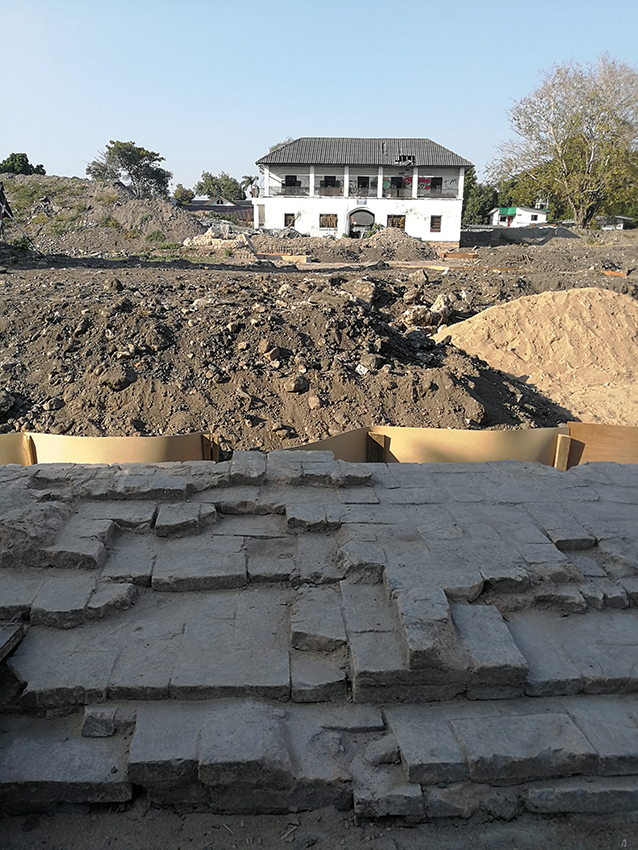Historic Prison - Wiang Kaeo Palace, Overlapping Cultural Heritage of Two Eras
Main Article Content
Abstract
The Wiang Kaeo Khuang Luang Development Project in Chiang Mai Province encompasses the historic prison and Wiang Kaeo Palace, exhibiting a complex interplay of positive and negative historical significance within the same locale. Initially serving as a revered landmark within the sacred city, Wiang Kaeo Palace transformed into a prison during the transition from Lanna to Siam, thereby acquiring divergent connotations in local Lanna beliefs. Consequently, a contentious debate has arisen regarding the complete demolition and relocation of the historic prison to restore the cultural value of Wiang Kaeo Palace to the local community.Conversely, the prison has garnered positive appraisal as a national heritage site symbolizing judicial history, resulting in its designation as a historic monument—a designation that remains firmly entrenched in history.
Employing the People-Centered Approach within contemporary conservation theory, this study scrutinizes and dissects the cultural heritage of both the historic prison and Wiang Kaeo Palace. Through literature reviews, participatory observation, and content analysis, the research delves into four key issues: 1) ascribing value and significance to social, cultural, historical, and archaeological dimensions; 2) interpretation; 3) utilization; and 4) participation. Despite embodying both positive and negative values and meanings, the historic prison suffers from a shortage of positive social, cultural, and communal significance. Nevertheless, a discernible trend exists towards collaborative progress in integration and development. Nonetheless, a desire persists to dismantle the prison and apprehensions regarding its preservation and portrayal as a monument. Positive engagement entails preserving the prison in tandem with Wiang Kaeo Palace. Reverence for local communities and the fostering of their active involvement emerge as pivotal elements in conservation efforts and people-centered development, thereby nurturing the well-being of both heritage sites and communities.
Downloads
Article Details

This work is licensed under a Creative Commons Attribution-NonCommercial-NoDerivatives 4.0 International License.
References
Ashworth, Gregory, and Peter Howard. European Heritage Planning and Management. Bristol: Intellect, 1999.
Avrami, Erica, Susan Macdonald, Randall Mason, and David Myers. Values in Heritage Management: Emerging Approaches and Research Directions. Los Angeles: Getty Publications, 2019.
Court, Sarah, and Gamini Wijesuriya. People-Centered Approaches to the Conservation of Cultural Heritage: Living Heritage. Rome: International Centre for the Study of the Preservation and Restoration of Cultural Property, 2015.
Dome Kraipakorn. “Khum lūang læ Wīang Kǣo khō̜ng čhao Chīang Mai nai samai ratchakān thī hā : rư̄angrāo thī mai thūk lao thưng nai phongsāwadān Sayām læ rō̜ngrō̜i thī phop nai lakthān ʻư̄ n [King of Chiang Mai’s “Khum Luang” / “Wiang Khaew” in the Era of King Chulalongkorn: the Untold Story in Siam-Chronicle and Traces Founded in Other Sources].” NAJUA: History of Architecture and Thai Architecture 10 (September 2013–August 2014): 10-25.
Johnston, Chris, and David Myers. “Resolving Conflict and Building Consensus in Heritage Place Management: Issues and Challenges.” 1-23. In Proceedings of a Workshop “Consensus Building, Negotiation, and Conflict Resolution for Heritage Place Management.” Los Angeles, United States. December 1-3, 2009.
Khajornsak Buaraphan. Wičhai choē ng khunnaphāp mai yāk yāng thī khit [Qualitative Research Is Not a Tough Task]. 7th ed. Bangkok: Comma Design & Print, 2017.
Khalaf, Roha W. “Roadmap for the Nomination of Reconstructed Cultural Properties for Inscription on the UNESCO World Heritage List.” Heritage 1, 2 (2018): 189-206.
Manager Online. Sinlapā kō̜n phoē i phon khut khon phop nǣo kamphǣng “Wīang Kǣo” klāngmư̄ ang Chīang Mai lakthān chī chat thī tang phra rāt chawang Phayā Mangrāi [The 7th Regional Office Fine Arts, Chiang Mai Reveals the Results of Excavation and the Discovery of the “Wiang Kaeo” Wall in the City Center of Chiang Mai. Evidence Clearly Indicates the Location of Phaya Mangrai Palace]. Accessed January 24, 2020. Available from https://mgronline.com/local/detail/9640000007170
Meskell, Lynn. “Negative Heritage and Past Mastering in Archaeology.” Anthropological Quarterly 75, 3 (Summer 2002): 557–574.
Moses, Sarah. “Stigmatized Space: Negative Heritage in Historic Preservation.” Master’s Thesis, University of Pennsylvania, 2015.
Office of Archaeology, The 7th Regional Office of Fine Arts, Chiangmai. Kitčhakam banyāi phoē iphrǣ khwāmrū sū sāthārana “Wīang Kǣo : Khum Khing Khing (phāk bāi) [Activities to Disseminate Knowledge to the Public. Wiang Kaeo: the Palace of Lanna (Afternoon Session)]. February 3, 2021. Video, 26:59. Available from https://fb.watch/quEONzQKFY/?mibextid=v7YzmG
Patiphol Yodsurang. “Nǣothāng kānʻanurak mō̜radok thāng thammachāt læ mō̜radok thāng watthanatham thī nēn phūkhon pen sūnklāng [People-centered Approaches to Conservation of Nature and Culture].” Journal of Environmental Design 7, 1 (January–June 2020): 3-21.
Piyadech Arkarapotiwong. “Kānsưksā khrōngsāng khwāmrūammư̄ nai kānčhatkān kō̜n kān pen mư̄ ang mō̜radok lōk kō̜ranī sưksā Chīang Mai prathēt Thai [The Study of Collaborative Structure of Pre-world Heritage Management; Case Study Chiang Mai, Thailand]. ”Journal of Architectural/Planning Research and Studies 16, 1 (January–June 2019): 125-137.
Poulios, Ioannis. “Discussing Strategy in Heritage Conservation: Living Heritage Approach as an Example of Strategic Innovation. ”Journal of Cultural Heritage Management and Sustainable Development 4, 1 (2014): 16-34.
Richter, Christine, Jakob Busse von Colbe, Henrik Beermann, and Urban Kaiser. Report Heritage Management in Thailand. Leipzig: Fraunhofer Center for International Management and Knowledge Economy IMW, 2020.
Sarassawadee Ongsakul. Prawat sāt Lān nā chabap sombūn [History of Lanna Complete Edition]. 12th ed. Bangkok: Amarin Printing and Publishing Public Company Limited, 2018.
Shalaginova, Iryna. “Understanding Heritage: a Constructivist Approach to Heritage Interpretation as a Mechanism for Understanding Heritage Sites.” Ph.D. Dissertation, Brandenburg University of Technology Cottbus, 2012.
Taylor, Joel, and May Cassar. “Representation and Intervention: the Symbiotic Relationship of Conservation and Value. ”Studies in Conservation 53, sup 1 (2008): 7-11.
Tunbridge, John, and Gregory Ashworth. Dissonant Heritage: the Management of the Past as a Resource in Conflict. Chichester: John Wiley & Sons Limited., 1996.
UNESCO World Heritage Centre. 2023 Operational Guidelines for the Implementation of the World Heritage Convention. 1-182. Accessed September 24, 2023. Available from https://whc.unesco.org/en/guidelines/
Viñas, Salvador Muñoz. Contemporary Theory of Conservation. Oxford: Elsevier Butterworth-Heinemann, 2005.
Worachat Michubot. Yō̜ ʻon ʻa dīt Lān nā tō̜n rūam rư̄ ang nā rū čhāk phǣnthī mư̄ ang nakhō̜n Chīang Mai [Going Back to the Past of Lanna, Collection of Interesting Things from the City Map of Chiang Mai]. 2nd ed. Bangkok: Chulalongkorn University Press, 2017.


